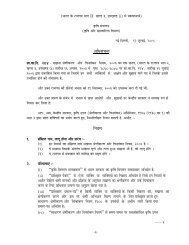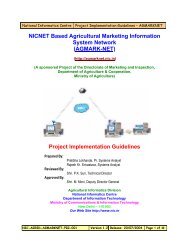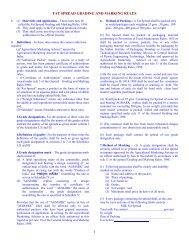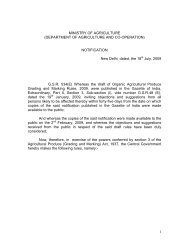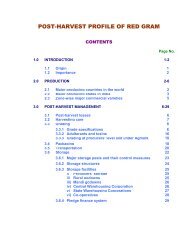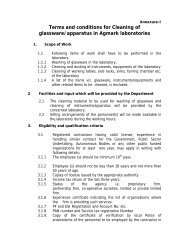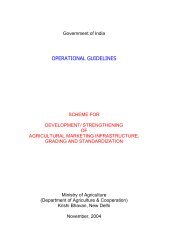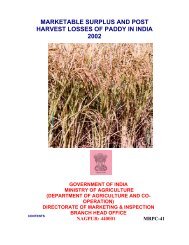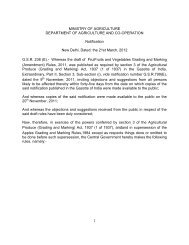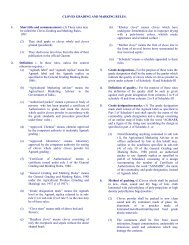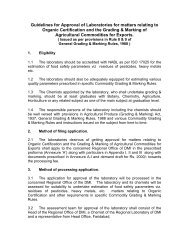marketable surplus and post harvest losses of ragi in ... - Agmarknet
marketable surplus and post harvest losses of ragi in ... - Agmarknet
marketable surplus and post harvest losses of ragi in ... - Agmarknet
- No tags were found...
Create successful ePaper yourself
Turn your PDF publications into a flip-book with our unique Google optimized e-Paper software.
CHAPTER-IISAMPLING DESIGN AND COVERAGE2.1 SAMPLING DESIGN :The Technical Committee recommended stratified multi-stage r<strong>and</strong>om sampl<strong>in</strong>g design for this survey.The selection <strong>of</strong> districts was done on aggregate method <strong>of</strong> production for all crops <strong>of</strong> foodgra<strong>in</strong>s.Accord<strong>in</strong>gly, selection <strong>of</strong> districts was done @ 20% <strong>of</strong> total number <strong>of</strong> districts <strong>of</strong> each state, <strong>in</strong>stead <strong>of</strong>tak<strong>in</strong>g 20% at the National level <strong>and</strong> allocat<strong>in</strong>g them among the states on the basis <strong>of</strong> their size <strong>and</strong>production, as followed earlier by the DMI, for ensur<strong>in</strong>g reliable estimates <strong>of</strong> <strong>marketable</strong> <strong>surplus</strong>, bothat the State <strong>and</strong> National level. The sampl<strong>in</strong>g design consisted <strong>of</strong>:i) In each state, 20% <strong>of</strong> the total number <strong>of</strong> districts were selected for the survey.ii) In each selected district, 15 (Fifteen) villages were selected after group<strong>in</strong>g <strong>in</strong>to threestratums, based on total area cultivated under foodgra<strong>in</strong>s.iii) In each selected village, 10 (Ten) cultivator households were selected afterclassify<strong>in</strong>g them <strong>in</strong>to three categories viz., Small, Medium <strong>and</strong> Large.Accord<strong>in</strong>gly, the total number <strong>of</strong> districts selected on all India basis worked out to 100 (One hundred),the total number <strong>of</strong> villages to be surveyed worked out to 1500 (100 districts X 15 villages) <strong>and</strong> 15000cultivator households (1500 villages X 10 cultivator households), from whom the data were collected <strong>in</strong>prescribed schedules on quarterly basis over a period <strong>of</strong> three years <strong>of</strong> survey.2.1.1 METHOD OF SAMPLINGSELECTION OF SAMPLE DISTRICTS:As stated earlier, <strong>in</strong> accordance with the procedure <strong>of</strong> sampl<strong>in</strong>g approved by the Technical Committee,<strong>in</strong> consultation with the Director, IASRI, New Delhi, Selection <strong>of</strong> districts was done on the basis <strong>of</strong>aggregate method <strong>of</strong> production for all crops <strong>of</strong> foodgra<strong>in</strong>s. The selection <strong>of</strong> districts was done @20% <strong>of</strong> the total number <strong>of</strong> districts <strong>of</strong> each state, <strong>in</strong>stead <strong>of</strong> tak<strong>in</strong>g 20% at the National level <strong>and</strong>allocat<strong>in</strong>g them among the States on the basis <strong>of</strong> their size <strong>of</strong> production, as was followed by the D.M.I.earlier. This was done to ensure reliable estimates <strong>of</strong> <strong>marketable</strong> <strong>surplus</strong> etc., both at the State <strong>and</strong>National level. All the districts, <strong>in</strong> each state were classified <strong>in</strong>to three categories, namely ‘High’,‘Medium’ <strong>and</strong> ‘Low’ production, based on annual production <strong>of</strong> foodgra<strong>in</strong> crops for three years (1991-92, 1992-93 & 1993-94). The data on annual production <strong>of</strong> foodgra<strong>in</strong>s was obta<strong>in</strong>ed from the StateDepartments. About 20% <strong>of</strong> the total districts <strong>in</strong> each state were selected, after clubb<strong>in</strong>g some States<strong>and</strong> Union Territories, so as to ensure selection <strong>of</strong> two districts from each category <strong>and</strong> atleast sixdistricts from each state. S<strong>in</strong>ce the number <strong>of</strong> districts <strong>in</strong> <strong>in</strong>dividual States ranged between 2 <strong>in</strong> Goa <strong>and</strong>63 <strong>in</strong> U.P., it posed a problem <strong>in</strong> respect <strong>of</strong> states hav<strong>in</strong>g less than 30 districts.i) States hav<strong>in</strong>g 30 or more districts:Bihar (42), Uttar Pradesh (63), Maharashtra (31) <strong>and</strong> Madhya Pradesh (45).ii) States hav<strong>in</strong>g more than 6 but less than 30 districts:Andhra Pradesh (23), Arunachal Pradesh (11), Assam (23), Gujarat (14), Haryana (16),Himachal Pradesh (12), J & K (14), Karnataka (20), Kerala (14), Manipur (8), Nagal<strong>and</strong> (7),Orissa (13), Punjab (12), Rajasthan (27), Tamil Nadu (22) <strong>and</strong> West Bengal (17).iii) States/Union Territories (U.Ts.) hav<strong>in</strong>g 6 or less than 6 districts:Goa (2), Meghalaya (5), Mizoram (3), Sikkim (4), Tripura (3), Andaman & Nicobar (2),Pondicherry (4), Daman & Diu (2), Delhi (1), Ch<strong>and</strong>igarh (1), Lakshdweep (1) <strong>and</strong> DadraNagar Haveli (1).Therefore, clubb<strong>in</strong>g <strong>of</strong> some states <strong>and</strong> Union Territories was done to ensure selection <strong>of</strong> atleast twodistricts from each category. Accord<strong>in</strong>gly, 100 districts were selected for the survey on All Indiabasis.It may further be added here that while select<strong>in</strong>g the districts, it was ensured that these selecteddistricts contributed to nearly 20% <strong>of</strong> aggregate production <strong>of</strong> foodgra<strong>in</strong>s.




